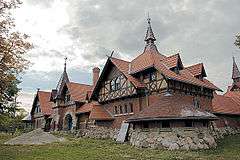National Museum of Puerto Rican Arts and Culture
Coordinates: 41°54′8.14″N 87°42′12.11″W / 41.9022611°N 87.7033639°W
 | |
| Established | 2001; in present location since 2009 |
|---|---|
| Location |
3015 West Division Street Chicago, Illinois 60622 P: 773.486.8345 |
| Director | Billy Ocasio |
| President | Ray Vázquez |
| Website | Official website |
The National Museum of Puerto Rican Arts and Culture (formerly, Institute of Puerto Rican Arts and Culture)[1] is a museum in Chicago dedicated to interpreting the arts and culture of the Puerto Rican people and of the Puerto Ricans in Chicago.[2] Founded in 2001, it is housed in the historic landmark Humboldt Park stables and receptory, near the Paseo Boricua.[3] It hosts visual arts exhibitions, community education, and festivals.[4][5] Its exhibitions have featured the artwork of Osvaldo Budet, Elizam Escobar, Antonio Martorell, Ramon Frade Leon, and Lizette Cruz, in addition to local Chicago or Puerto Rican artists.[6] The Institute also sponsors music events including an annual Navi-Jazz performance, described as a "fusion of Puerto Rican and African American musical elements."[7]
The Institute is a non-profit organization that is supported in part by the Chicago Park District's museum-in-the-parks program.[8][9] The museum is a member organization of the Chicago Cultural Alliance.
Institute building
The museum complex and the Park (named for Alexander von Humboldt)[10] were added to the National Register of Historic Places in 1991.[11] The building was designated a Chicago Landmark in 2008.[12] The stables and receptory were built by architects Fromman & Jebsen in 1895 as part of the development of the park.[13] They are designed in a "visually dramatic" Queen Anne revival style.[2][12] In the building's early days, noted landscape architect and Danish immigrant, Jens Jensen, had his park design offices here.[13]
The building suffered a major fire in 1992 but was restored through the efforts of community leaders and the Park District. The Institute led renewal of the interior of the building including galleries, classrooms, and concession facilities.[13]
References
- ↑ "National Museum Puerto Rican Arts and Culture Celebrates its Historic Grand Opening". NMPRAC. September 2014. Retrieved 24 January 2015.
- 1 2 "Institute of Puerto Rican Arts and Culture: About". IPRAC. Retrieved 2013-05-27.
- ↑ "Open House Chicago". Chicago Architecture Foundation. Retrieved 2013-05-29.
- ↑ "Trailer Park Proyects: TPP awarded Chicago Community Trust through the Institute of Puerto Rican Arts and Culture (IPRAC) Chicago". Trailer Park Proyects. Retrieved 2013-05-27.
- ↑ "Institute of Puerto Rican Arts & Culture presents Trailer Park Proyects". Chicago Reader. Retrieved 2013-05-27.
- ↑ "Institute of Puerto Rican Arts and Culture: Exhibitions". IPRAC. Retrieved 2013-05-27.
- ↑ "Institute of Puerto Rican Arts and Culture: Events". IPRAC. Retrieved 2013-05-27.
- ↑ "Chicago Park District Approves Tax Subsidy to Institute of Puerto Rican Arts and Culture". The Civic Federation. Retrieved 2013-05-27.
- ↑ "Museums In the Park: About Us". Museums In the Park. Retrieved 2013-05-27.
- ↑ Badillo, David A. "Humboldt Park". Encyclopedia of Chicago. Chicago History Museum, Newberry Library, Northwestern University. Retrieved May 27, 2013.
- ↑ National Register of Historical Places in Cook County, IL. Retrieved May 27, 2013.
- 1 2 "Humboldt Park Receptory Building & Stable". Commission on Chicago Landmarks Div. 2009. Retrieved 2013-05-27.
- 1 2 3 "Institute of Puerto Rican Arts and Culture: Our Building". IPRAC. Retrieved 2013-05-27.